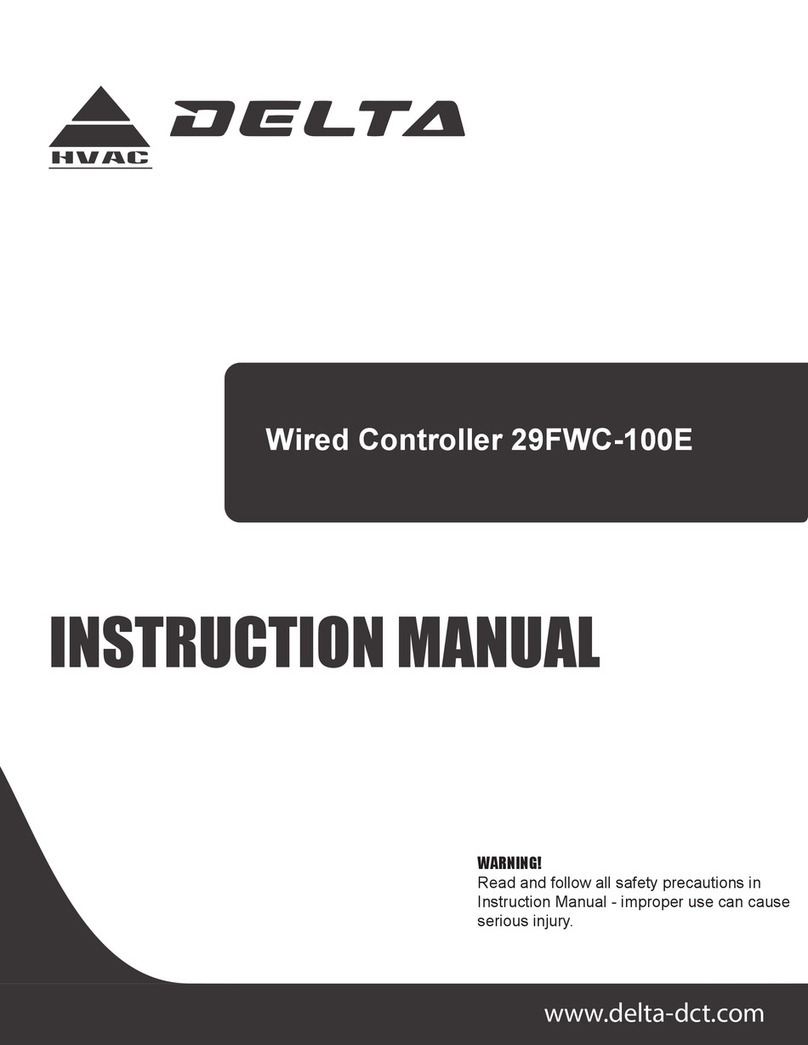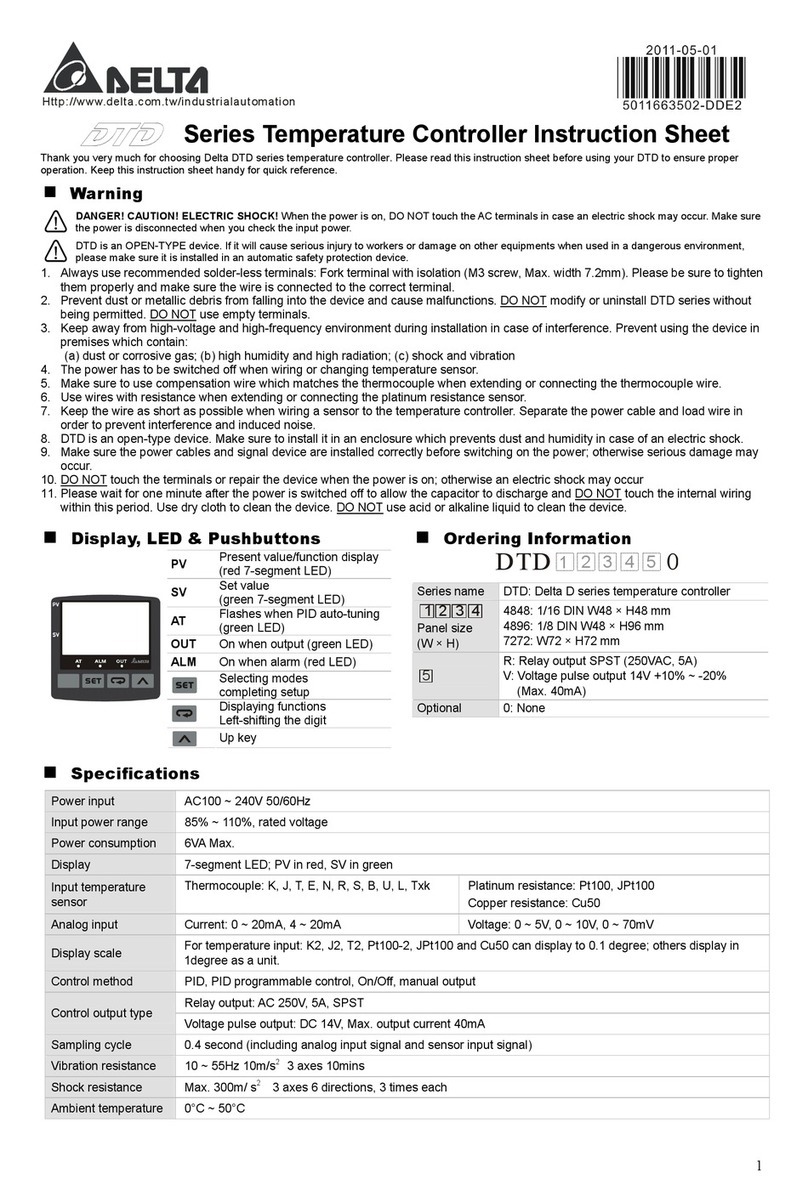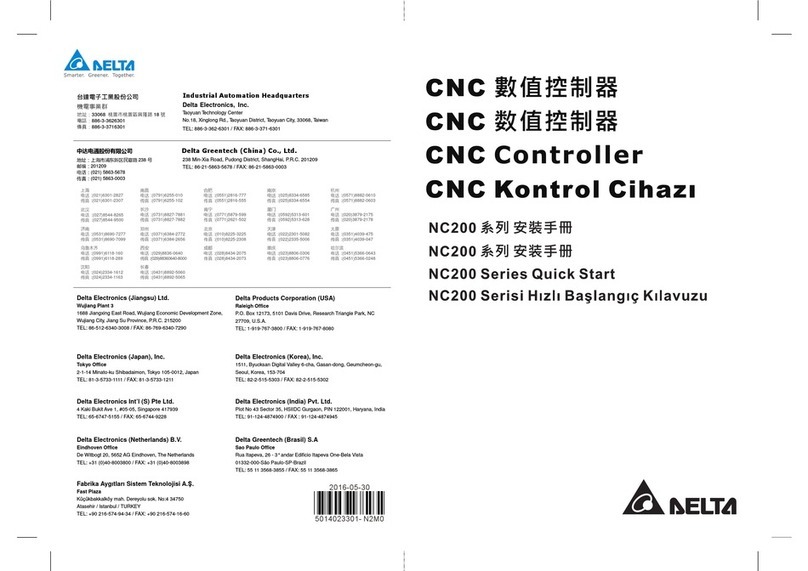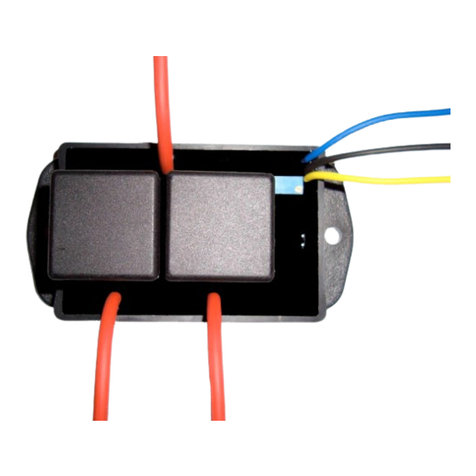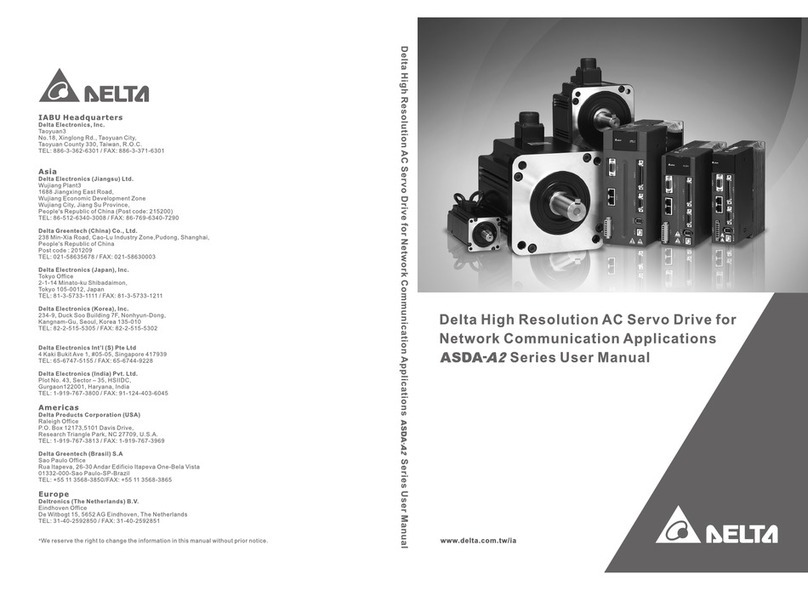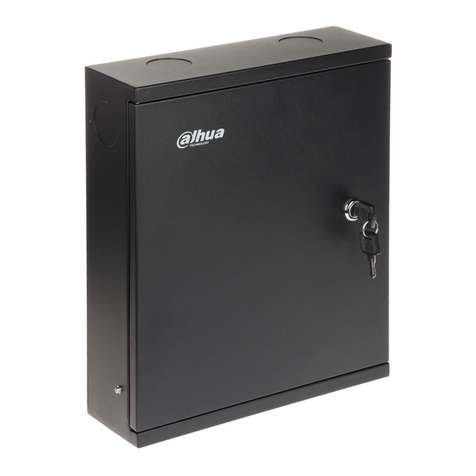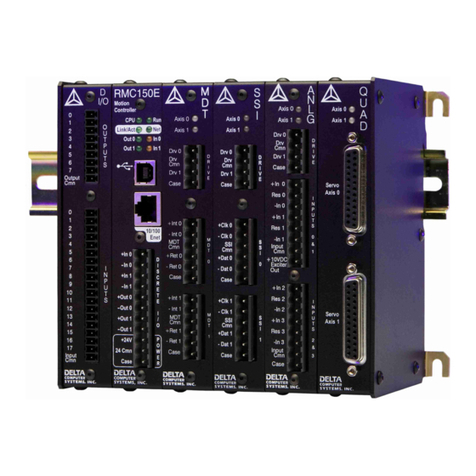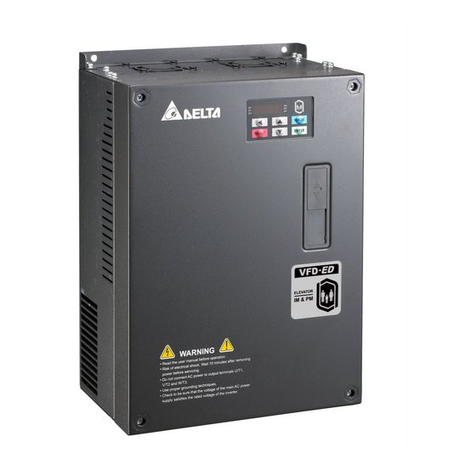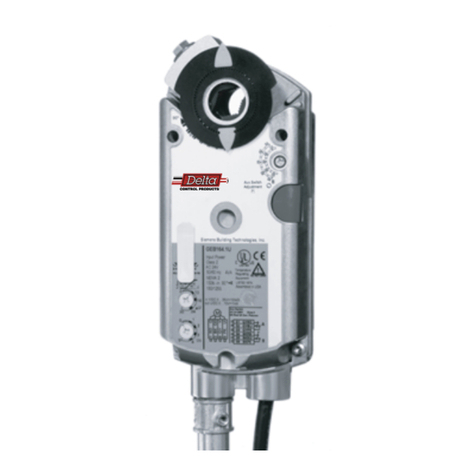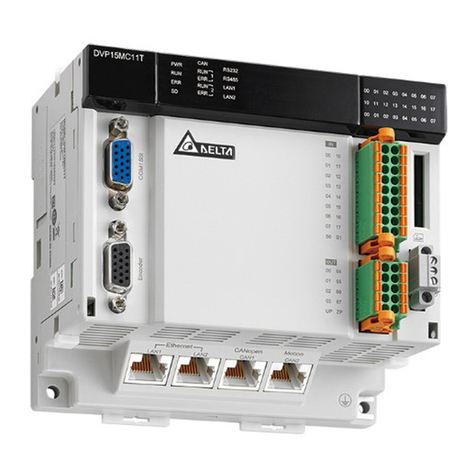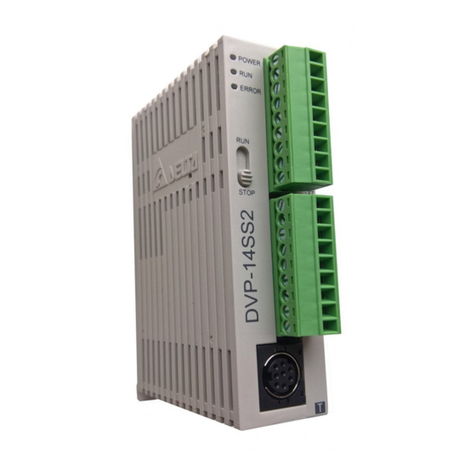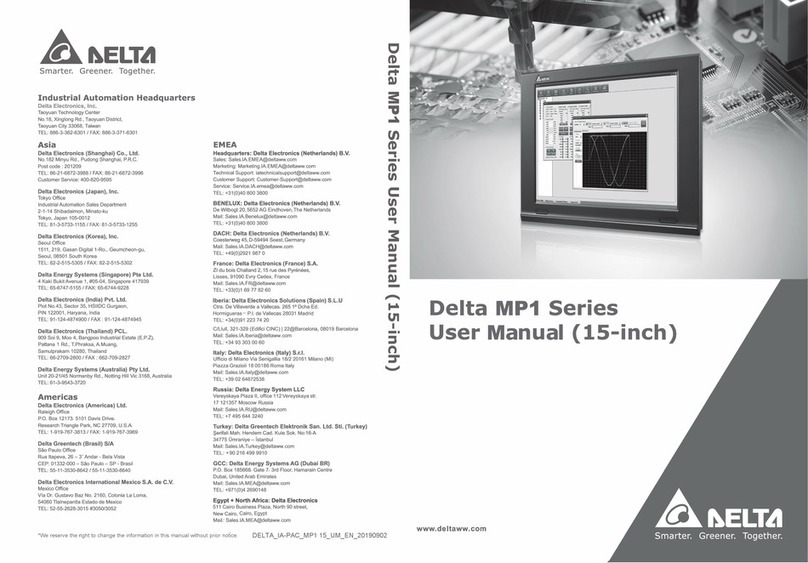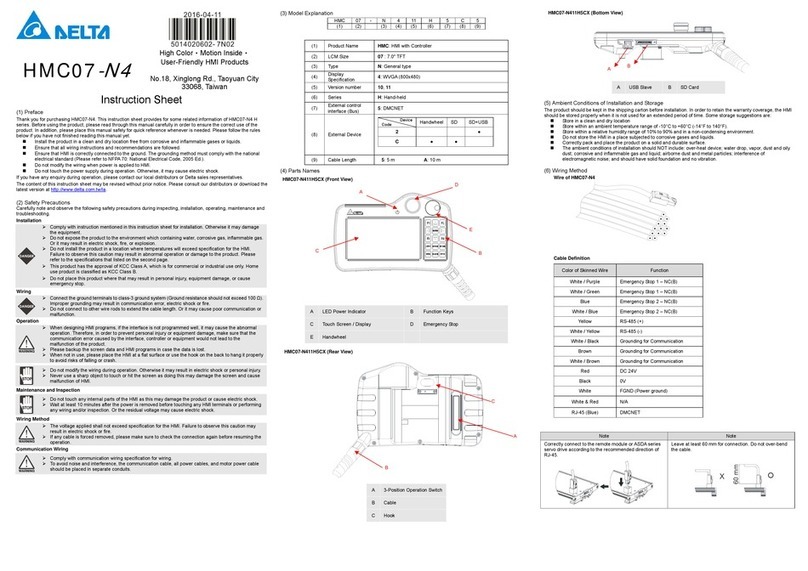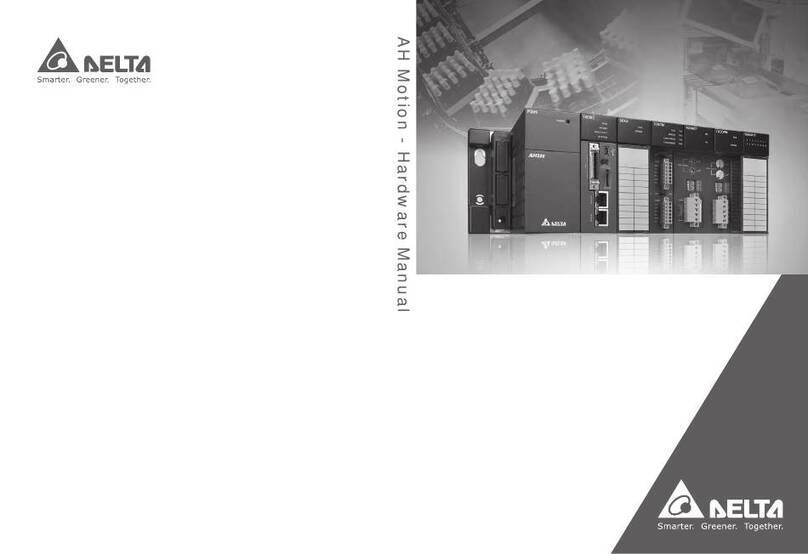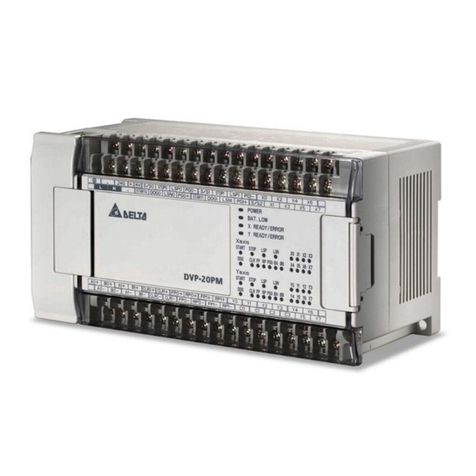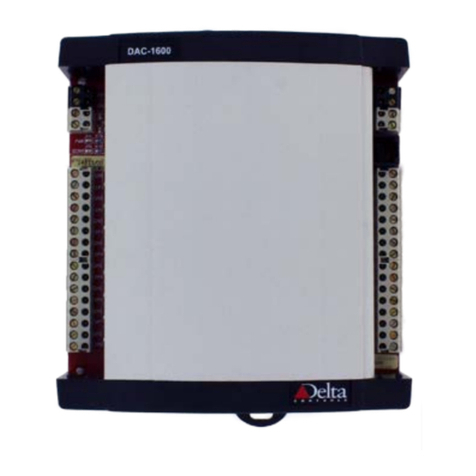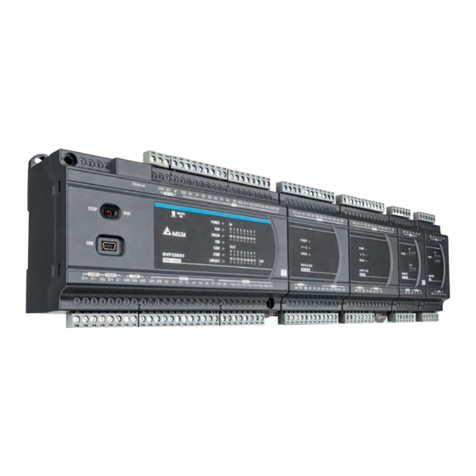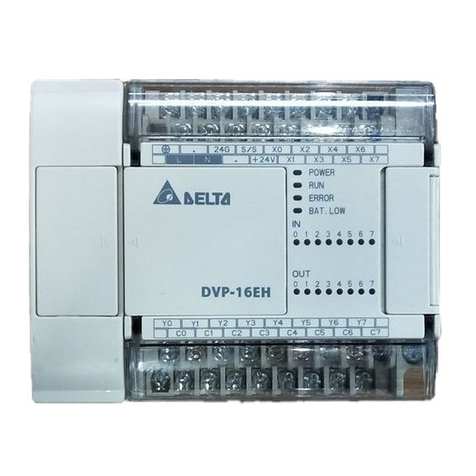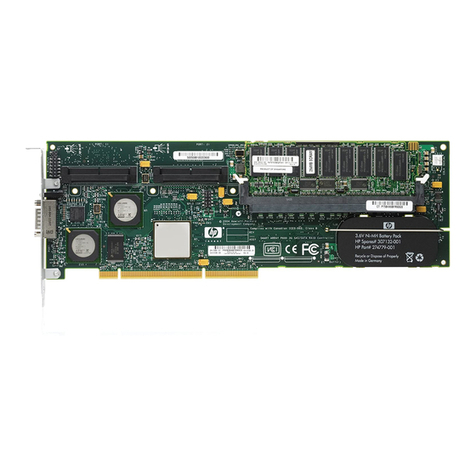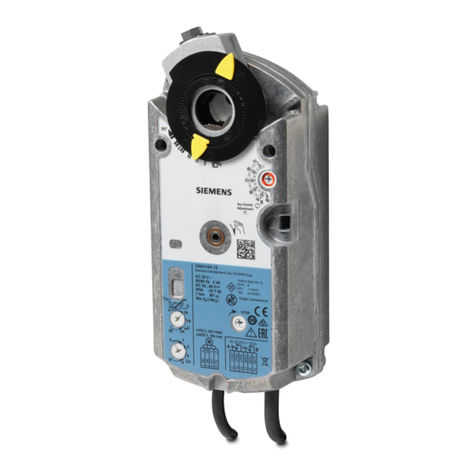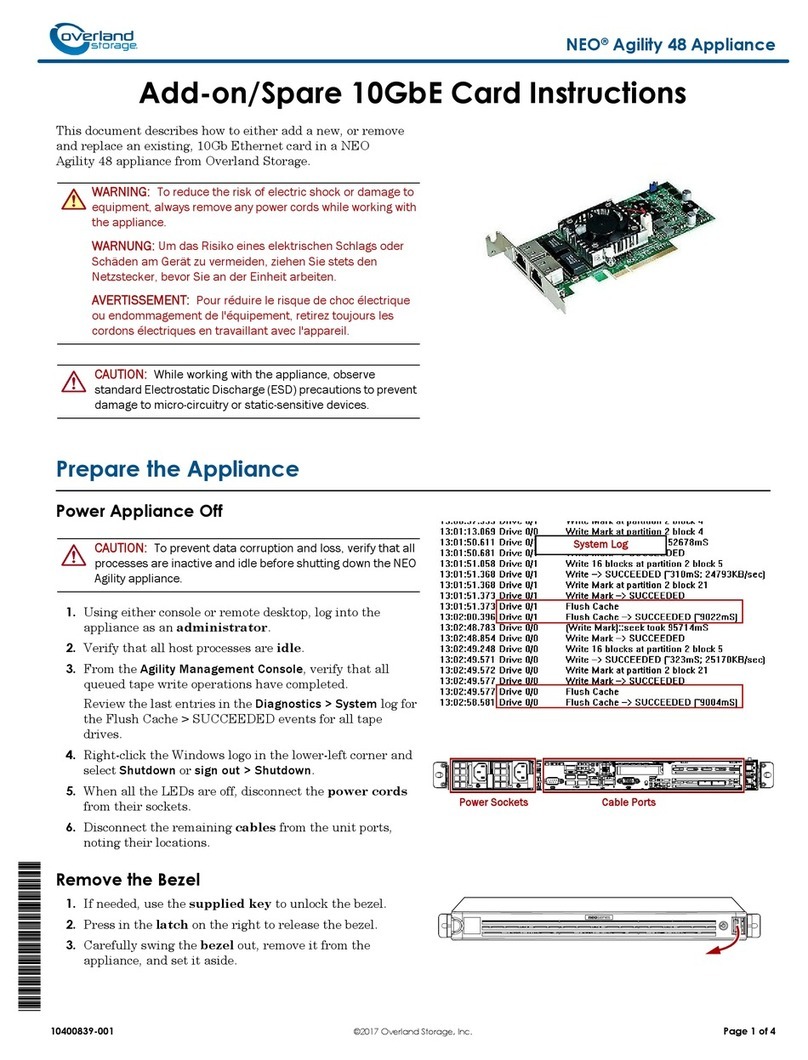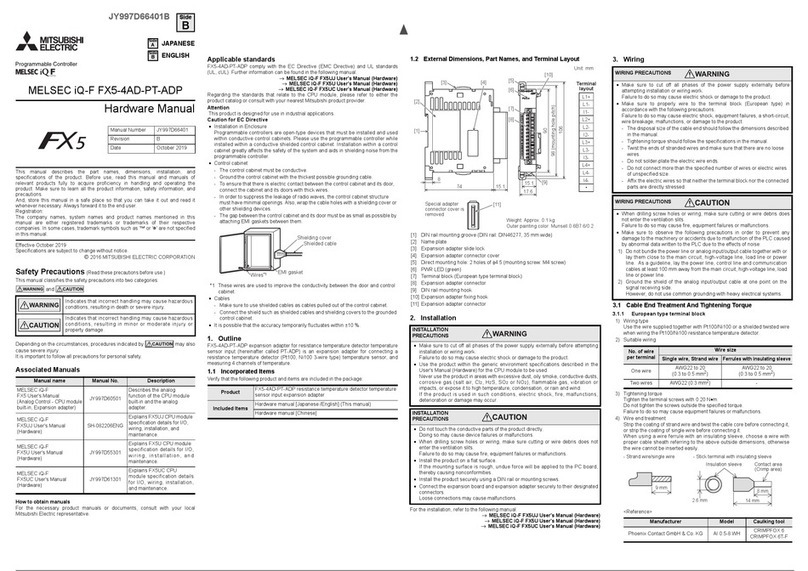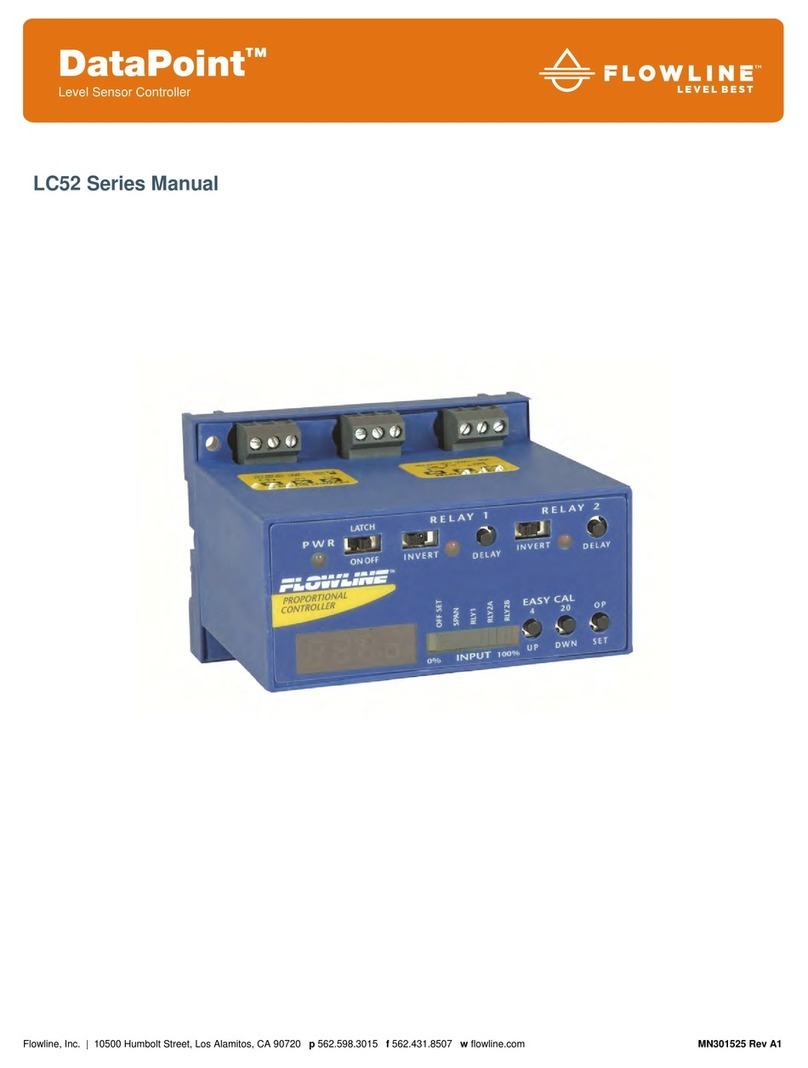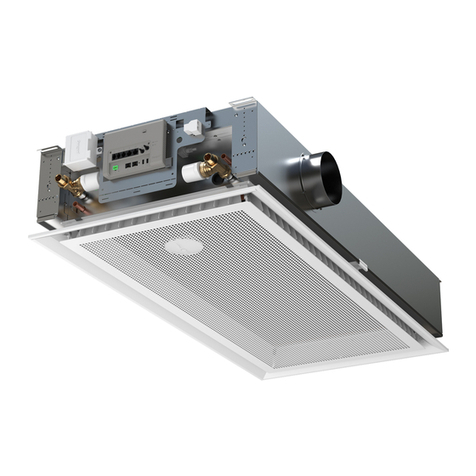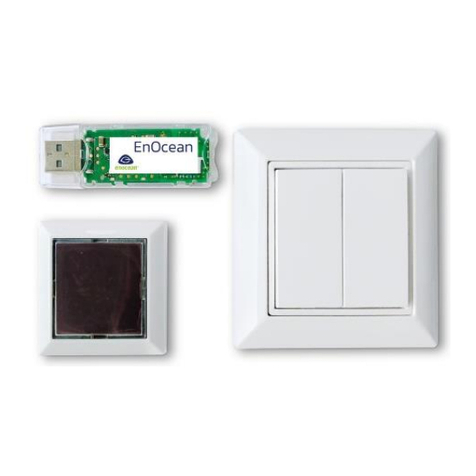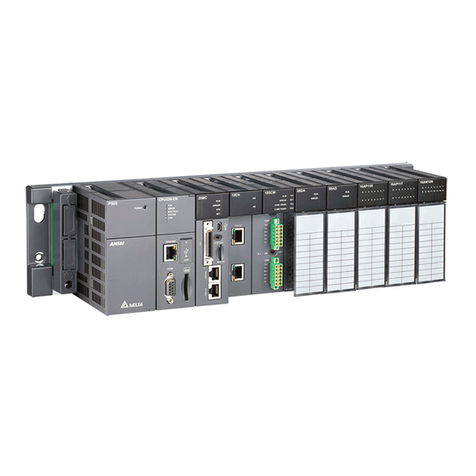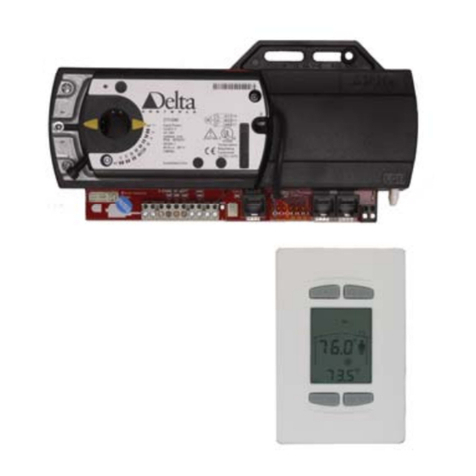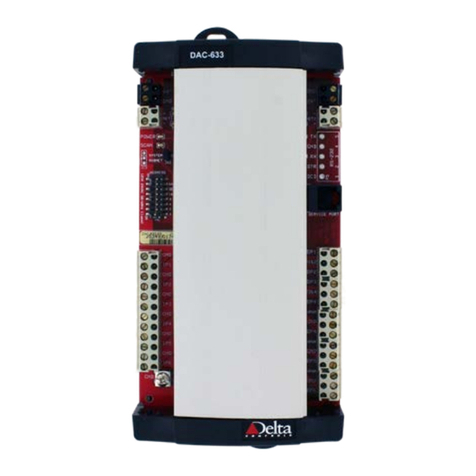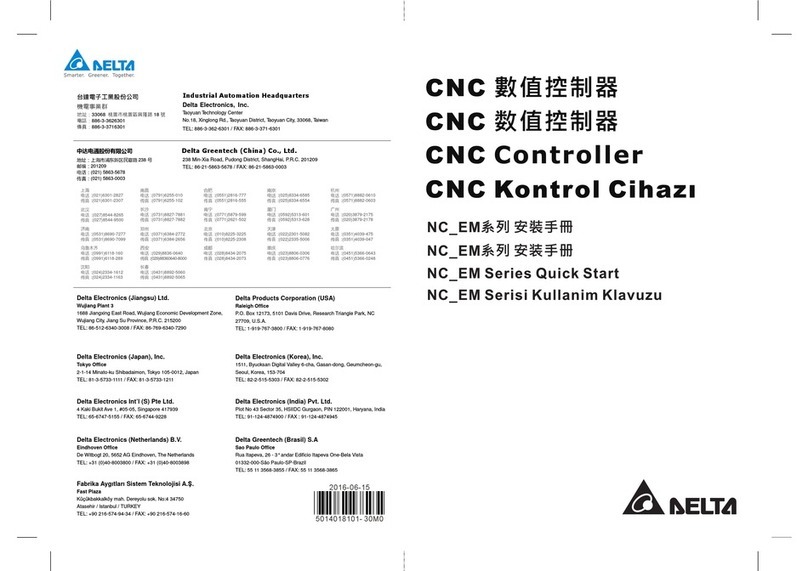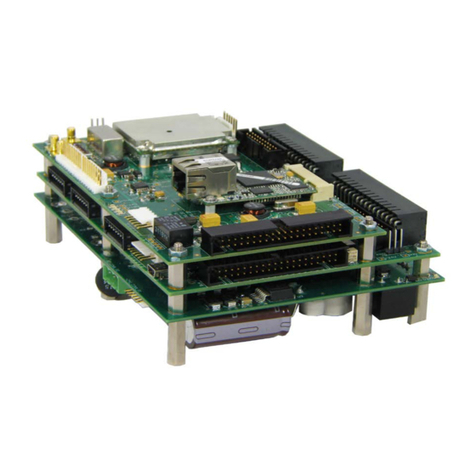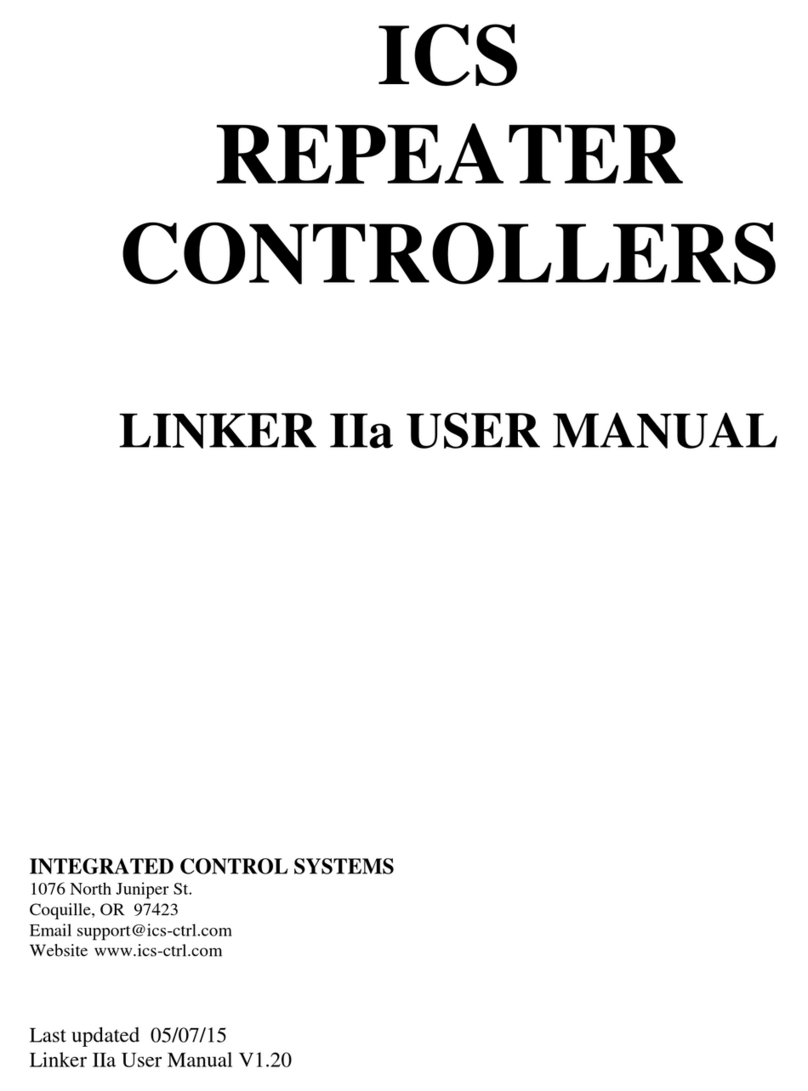
www.delta.com.tw/products/plc.asp
DVP-SA
Compact, Multi-function,
Multiple Commands PLC
Instruction Sheet
1 WARNING
This Instruction Sheet only provides descriptions for electrical specifications, general specifications, installation &
wiring, troubleshooting and peripherals. Other detail infromation about programming and commands is compatible
with EP series; please see PLC Application Manual. For more information about the optional peripherals , please
see individual product manual.
This is an OPEN TYPE PLC. The PLC should be kept in an enclosure away from airborne dust, humidity, electric
shock risk and vibration. Also, it is equipped with protective methods such as some special tools or keys to open
the enclosure, so as to avoid the hazard to users and the damage to the PLC.
Never connect the AC main circuit power supply to any of the input/output terminals, as it will damage the PLC.
Check all the wiring prior to power up. To avoid any electromagnetic noise, make sure the PLC is properly
grounded .
2 INTRODUCTION
2.1 Model Name Explanation and Peripherals
Thank you for choosing DELTA’s PLC DVP series. The
DVP-SA series has a 12-points (8 input points + 4
outputs) PLC main processing unit with multiple
commands for use. It also has an 8K Steps program
memory to connect to every SS series expansion unit,
including digital I/O (Maximum 112 Input / 112 Output
expansion points), analog module, etc. for various
applications. Its power unit is separated from the MPU
for better space utilization and easier installation.
Nameplate Explanation
PLC Model
Input Power Supply Spec.
Output Module Spec.
Barcode and Serial Number
CPU Version
MODEL : DVP12SA11R
POWER INPUT : 24DC 6W MAX
OUTPUT MODULE : 2.0A250Vac 50/60Hz RES. LOAD
DELTA E L E CTRON I CS I NC . MADE IN XXXXXX
V1.00
12SA11R0T4020001
Model Name
Series Name
Points (8 inputs + 4 ou tputs)
SA Series R: Relay
T: Transistor
DC Power Input
Serial Number
Production number
Production week
Production Year 2004
Production factory
Version type
Production model
Peripherals
◎ DVPHPP02: Handheld Programming panel
◎ WPLSoft: Windows Ladder Logic Programming Software
◎ DVPACAB115: 1.5M Cable (HPP PLC, included in DVPHPP02)
◎ DVPACAB215: 1.5M Cable (PC (DB9+DB25) PLC)
◎ DVPACAB230: 3.0M Cable (PC (DB9+DB25) PLC)
◎ DVPACAB2A30: 3.0M Cable (PC (DB9) PLC)
2.2 Product Profile and Outline
1 Status indicator: POWER, RUN,
ERROR, BAT.LOW
2 RUN/STOP switch
3 VR0: M1178 Start-up/D1178
Corresponding value
4 VR1: M1179 Start-up/D1179
corresponding value
5 DIN rail clip
6 I/O terminals
7 I/O point indicators
8 COM1 (RS-232) (Rx) indicator
9 COM2 (RS-485) (Tx) indicator
10 COM1 (RS-232) programming port
11 Nameplate
12 Expansion port
13 Mounting hold of the expansion unit
14 DIN rail (35mm)
15 Expansion unit clip
16 COM2 (RS-485) Communication
port
17 DC Power input
18 RS-485 Cable (standard accessory)
19 Power input cable (standard
accessory)
20 Battery Cover
21 Battery socket connection
RUN
RUN
ERROR
POWER
Y3
RS-232
RS-485
Y1
Y2
C2
Y0
C1
Units :mm
※ Battery replacement: Please change the battery within 3 minutes, or
the internal data of the PLC (including the program area, perpetual
calendar and latched registers) could be lost or destroyed.
22 Battery mount
3 FUNCTION SPECIFICATIONS
Items Specifications Remarks
Control Method Stored program, cyclic scan system
I/O Processing Method Batch processing method (when END command
is executed) I/O refresh command is available
Execution Speed Basic commands (several us) Application Commands
(10~hundreds us)
Program language Commands + Ladder Logic + SFC Including the Step commands
Program Capacity 7920 STEPS SRAM + Battery
Commands 32 Basic sequential commands (including
STL/RET) 168 Application commands
X External input relay X0~X177, octal number system, 128
points Correspond to external input point
Y External output relay Y0~Y177, octal number system, 128
points
Tota l
256
points Correspond to external output point
General M0~M511, 512 points (*1)
M512~M999, 488 points (*3)
Latched M2000~M4095, 2096 points (*3)
M Auxiliary
Relay
Special M1000~M1999, 1000 points (some are
latched)
Tota l
4096
points
Contacts can switch to On/Off in
program
T0~T199, 200 points (*1)
T192~T199 for Subroutine
100ms
T250~T255, 6 points Accumulative (*4)
T200~T239, 40 points (*2)
10ms T240~T245, 6 points Accumulative (*4)
T Timer
1ms T246~T249, 4 points Accumulative (*4)
Tota l
256
points
When the timer that set by TMR
command reaches the preset value,
the T contact with the same number
will be On.
C0~C95, 96 points (*1)
16-bit count up C96~C199, 104 points (*3)
C200~C215, 16 points (*1)32-bit count
up/down C216~C234, 19 points (*3)
C235~C242, 1 phase 1 input, 9 points (*3)
C246~C249, 1 phase 2 input, 3 points (*3)
C Counter
32bit
high-speed
count up/down C251~C254, 2 phase 2 input, 3 points (*3)
Tota l
250
points
When the counter that set by CNT
(DCNT) command reaches the
preset value, the C contact with the
same number will be On.
Initial step point S0~S9, 10 points (*1)
Zero point
reset
S10~S19, 10 points (use with IST
command) (*1)
General S20~S511, 492 points (*1)
Latched S512~S895, 384 points (*3)
Relay (bit mode)
S Step
point
Alarm S896~S1023, 124 points (*3)
Tota l
1024
points
Usage device of step ladder diagram
(SFC)
Latched Range:
Start: D1214 (K512)
End: D1215 (K895)
T Current value of the
timer T0~T255, 256 points When the timer reaches the preset
value, the contact of timer will be On.
C0~C199, 16-bit counter, 200 points
C Current value of the
counter C200~C254, 32-bit counter, 50 points
When the counter reaches the
preset value, the contact of counter
will be On.
General D0~D199, 200 points (*1)
D200~D999, 800 points (*3)
Latched D2000~D4999, 3000 points (*3)
Special D1000~D1999, 1000 points
D Data
register
Index E0~E3, F0~F3, 8 points (*1)
Tota l
5000
points
Can be memory area for storing
data. E and F can be used as the
special purpose of index indication.
Register (WORD data)
None
File register 0~1599 (1600 points) (*4) Expansion register for storing data.
N For master control
nested loop N0~N7, 8 points Control point of master control
nested loop
P For CJ, CALL commands P0~P255, 256 points The location point of CJ, CALL.
External interrupt
I001 (X0), I101 (X1), I201 (X2), I301 (X3), I401
(X4), I501 (X5); 6 points (all are rising-edge
trigger)
Time interrupt I6□□ (1ms), I7□□ (1ms), (□□=1~99ms)
Hi-speed counter I010, I020, I030, I040, I050, I060; 6 points
Pointer
I
Interrupt Service
Communication I150, 1 point
The location pointer of interrupt
subroutine
K-32,768 ~ K32,767 (16-bit operation)
K Decimal K-2,147,483,648 ~ K2,147,483,647 (32-bit operation)
Constant
H Hexadecimal H0000 ~ HFFFF (16-bit operation), H00000000 ~ HFFFFFFFF (32-bit operation)
Programming port COM1: RS-232, COM2: RS-485 (Master/Slave), They can be used at the same time.
Analog Volume / Perpetual
Calendar (RTC) MPU built-in 2 points VR / MPU built-in RTC
Special Expansion Module Use the same modules (AD, DA, PT, TC, XA, RT) of SS series. (Max. 8 Expansion Unit
points)
*1: The non-latched area is fixed, and can’t be changed.
*2: The non-latched area can be changed to a latched area with parameter setting.
*3: The latched area can be changed to a non-latched area with parameter setting.
*4: The latched area is fixed, and can’t be changed.
General Latched Special auxiliary relay Latched
M0~M511 M512~M999 M1000~M1999 M2000~M4095
Latched (default) Latched (default)
M
Auxiliary
Relay Non-latched (fixed) Start: D1200 (K512)
End: D1201 (K999)
Some are latched and
can’t be changed Start: D1202 (K2000)
End: D1203 (K4095)
100 ms 10 ms 10ms 1 ms 100 ms
T0 ~T199 T200~T239 T240~T245 T246~T249 T250~T255
T
Timer Non-latched (fixed) Non-latched (fixed) Accumulative Latched (fixed)
16-bit count up 32-bit count up/down 32-bit high-speed count up/down
C0~C95 C96~C199 C200~C215 C216~C234 C235~C245 C246~C255
Latched (default) Latched (default) Latched (default)
C
Counter Non-latched
(fixed) Start: D1208 (K96)
End: D1209 (K199)
Non-latched
(fixed) Start: D1210 (K216)
End: D1211 (K234)
Start: D1212 (K235)
End: D1213 (K255)
General Latched Special registers Latched
D0~D199 D200~D999 D1000~D1999 D2000~D4999
Factory setting is latched. Factory setting is latched.
D
Register Non-latched (fixed) Start: D1216 (K200)
End: D1217 (K999)
Some are latched and
can’t be changed. Start: D1218 (K2000)
End: D1219 (K4999)
K0~K1599
File Register Latched (fixed)
※When switching between power On/Off or MPU RUN/STOP modes:
Memory Type POWER
OffOn STOPRUN RUNSTOP Clear all M1031
non-latched area
Clear all M1032
latched area
Factory
Setting
M1033=Off, clear
Non-latched Clear Unchanged
M103=On,
unchanged
Clear Unchanged 0
Latched Unchanged Unchanged Clear 0
Special M, Special
D, Index register Initial value Unchanged Unchanged Initial
value
File register Unchanged 0
4ELECTRICAL SPECIFICATIONS
Model
Item DVP12SA11R/T DVP08SM11N DVP08SN11R/T DVP08SP11R/T DVP16SP11R/
Power supply voltage MPU: 24VDC (-15%~20%) (with DC input reverse polarity protection),
Expansion Unit: supplied by the MPU
Fuse 2A / 250VAC -
Power Consumption 6W 5W 5W 8W 8W
Insulation Resistance > 5 MΩat 500 VDC (Between all inputs / outputs and earth)
Noise Immunity
ESD: 8KV Air Discharge
EFT: Power Line: 2KV, Digital I/O: 1KV, Analog & Communication I/O: 250V
Damped-Oscillatory Wave: Power Line: 1KV, Digital I/O: 1KV
RS: 26MHz~1GHz, 10V/m
Grounding The diameter of grounding wire cannot be smaller than the wire diameter of
terminals L and N (All DVP units should be grounded directly to the ground pole).
Environment Operation: 0℃~55℃(Temperature), 50~95% (Humidity), Pollution degree 2;
Storage: -25℃~70℃(Temperature), 5~95% (Humidity)
Vibration / Shock Resistance Standard: IEC1131-2, IEC 68-2-6 (TEST Fc) / IEC1131-2 & IEC 68-2-27 (TEST Ea)
Weight (approx.) (g) 158 128 154 /146 141 /136 162 /154
Input Point Electrical Specification Output Point Electrical Specification
Input Type DC (SINK or SOURCE) Output Type Relay-R Transistor-T
Input Curren
24VDC 5mA
Current
Specification 1.5A/1 point
(5A/COM)
0.3A/1 point @ 40℃; When the output
of Y0 and Y1 is high-speed pulse, Y0
and Y1 = 30mA
Off→On, above16VDC Voltage
Specification
Below 250VAC,
30VDC 30VDC
Active Level On→Off, below
14.4VDC
75VA
(Inductive)
Maximum
Loading 90 W
(Resistive)
9W/1 point
When the output of Y0 and
Y1 is high-speed pulse, Y0
and Y1 = 0.9W (Y0 =
32kHz, Y1 = 10kHz)
Responding
Time
About 10ms (An
adjustment range of
0~10,000ms could be
selected through D1020
and D1021)
Responding
Time About 10 ms
Off→On
20us
On→Off
30us
Y0 and Y1 are specified
points for high-speed pulse
5MODEL NAME & I/O CONFIGURATION
◎Standard MPU
Input / Output
Input Unit Output Unit
Model Power Point Type Point Type
Profile
reference I/O Configuration
DVP12SA11R 8 4 Relay
DVP12SA11T
24VDC
8
DC Sink or
Source
4 Transistor
S/S
X0
X1
X2
X3
X4
X5
X6
X7
C0
Y0
C1
C2
Y1
Y2
Y3
6INSTALLATION & WIRING
6.1 PLC Mounting Arrangements and Wiring Notes
Installation of the DIN rail
The DVP-PLC can be secured to a cabinet by using the
DIN rail that is 35mm high with a depth of 7.5mm. When
mounting the PLC on the DIN rail, be sure to use the end
bracket to stop any side-to-side motion of the PLC, thus to
reduce the chance of the wires being pulled loose. At the
bottom of the PLC is a small retaining clip. To secure the
PLC to the DIN rail, place it onto the rail and gently push
up the clip. To remove it, pull down the retaining clip and
gently pull the PLC away from the DIN rail. As shown on
the right:
When installing the DVP
series PLC, make sure that it is
installed in an enclosure with
sufficient space (as shown
below) to its surroundings so as
to allow heat dissipation.
DVP
MP
D
D
DD
D > 50 mm
Wiring
22-16AWG
<1.5mm
Notes:
1Please use 22-16AWG (1.5mm) wiring (either single or multiple core) for I/O
wiring terminals. The specification for the terminals is as shown on the left. PLC
terminal screws should be tightened to between 5~8 kg-cm (4.3~6.9 in-lbs).
2I/O signal wires or power supply should not run through the same multi-wire
cable or conduit.
6.2 Wiring Notes
Environment
1. DO NOT store the PLC in an atmosphere that is dusty, smoky, with metallic debris or corrosive or flammable gases.
2. DO NOT store the PLC in an environment with high temperature or high humidity.
3. DO NOT install the PLC on a shelf or on an unstable surface.
Power Input Wiring
DVP-SA series input power supply is DC input. Please take a note of listed items when operating DVP-SA.
Series.


